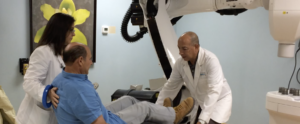
There’s no denying it, SBRT, like CyberKnife is often the best treatment option for prostate cancer. If anyone tells you otherwise, seek out a second opinion from CyberKnife experts at a treatment center near you.
Here’s the latest research published in the medical journal Cancer, which proves once again Stereotactic Body Radiotherapy greatly reduces the risk of acute side effects.
Here’s the breakdown of the study:
Magnetic resonance (MR)‐guided adaptive stereotactic body radiotherapy (SBRT) for prostate cancer was associated with significantly lower rates of acute genitourinary and gastrointestinal toxicities compared with CT-guided non-adaptive SBRT, according to a systematic review and meta-analysis.
Across 29 prospective studies involving over 2,500 patients, the risk of short‐term genitourinary side effects was reduced by 44% with MR-guided adaptive SBRT versus CT-guided SBRT (OR 0.56, 95% CI 0.33-0.97, P=0.04), while the risk of short‐term gastrointestinal side effects was reduced by 60% (OR 0.40, 95% CI 0.17-0.96, P=0.04), reported Jonathan Leeman, MD, of the Dana-Farber Cancer Institute in Boston, and colleagues.
“These findings suggest that the technical advantages in precision of radiotherapy delivery afforded by [MR‐guided adaptive] SBRT translate to measurable clinical benefit,” they wrote in Cancer
Rates of acute grade 2 or higher genitourinary toxicities ranged from 5% to 33.3% in the MR-guided studies and from 9.1% to 46.7% in the CT‐guided studies, while rates of acute grade 2 or higher gastrointestinal toxicities ranged from 0% to 8.3% and from 2.0% to 23.3%, respectively. Pooled estimates for acute grade 2 or higher genitourinary and gastrointestinal toxicities across studies were 16% and 4% in the MR-guided SBRT studies, respectively, and 28% and 9% in CT-guided SBRT studies.
There were few, if any, grade 3 or higher toxicity events. The pooled estimate of genitourinary and gastrointestinal toxicities was 0% in the MR-guided studies and 1% in the CT-guided studies.
MR‐guided adaptive SBRT adjusts a patient’s radiation plan every day to account for anatomical changes and to monitor the position of the prostate in real time to ensure that treatment is being directed accurately. However, this technique requires more time and resources than standard techniques. Thus, Leeman and colleagues wanted to assess its effect on toxic events compared with standard procedures.
While the results from this review and meta-analysis support the use of MR-guided SBRT in prostate cancer, the authors acknowledged that it could not be determined “whether the observed toxicity reduction is related to MR guidance versus CT guidance or adaptive versus non‐adaptive treatment or both.”
“Because there are multiple technical differences between these approaches, further prospective investigation is needed to pinpoint the specific underlying causes, and in particular the role of daily adaptive planning,” Leeman and team concluded. “Whether late toxicity and cancer control rates differ with the use of [MR-guided adaptive] SBRT compared to CT‐[guided] SBRT will require longer follow‐up to determine.”
Peter Johnstone, MD, of the Moffitt Cancer Center in Tampa, Florida, noted that because the margins used were similar between the MR and CT cohorts, the difference in grade 2 or higher toxic effects was likely due to the use of adaptive planning.
Does this decrease in grade 2 or higher genitourinary and gastrointestinal toxicity for patients with prostate cancer “override the capital cost and resource requirements of the technology?” he asked. “At our center, the answer is ‘no.'”
Adaptive planning “requires physician and physics and/or dosimetry representation for the process,” he pointed out, and the time required limits its use on a daily basis.
“Our selective use of [MR-guided adaptive] SBRT, however, is for those cases that may clinically benefit from the adaptive technology and extra resources by clinically significant target dose escalation and/or organ at risk dose sparing,” he wrote, adding that this generally involves pancreas and central lung lesions.
“For now, for appropriate prostate cancer patients, we simply use [MR-guided radiotherapy] and are delighted with our outcomes,” Johnstone concluded.
This systematic review and meta-analysis included nine MR-guided SBRT studies and 20 CT‐guided SBRT studies, with a total of 2,547 patients (329 and 2,218, respectively).
Inclusion criteria for eligible trials included a prospective clinical trial design evaluating prostate SBRT, a sample size of ≥10 patients, a prostate SBRT regimen that was delivered in four to five fractions, the use of photon radiation, a total dose of 35-45 Gy, and documentation of acute toxicity rates.
Written By Mike Bassett for MedPage
Prostate cancer is among the diseases we treat the most at CyberKnife Miami. Our oncology team has been using CyberKnife technology for 20 plus years and radiation therapy for the treatment of cancer much longer than that. Experience counts and our vast experience results in much better outcomes for our patients
If you want to get prostate cancer treated effectively, safely and as quickly as possible, call us now for a consultation. No referral is necessary 305-279-2900.
